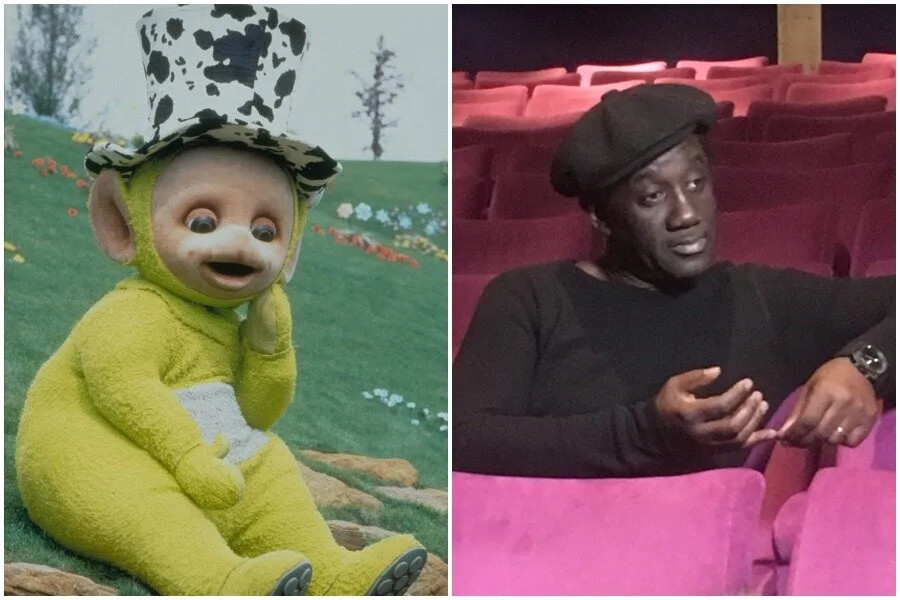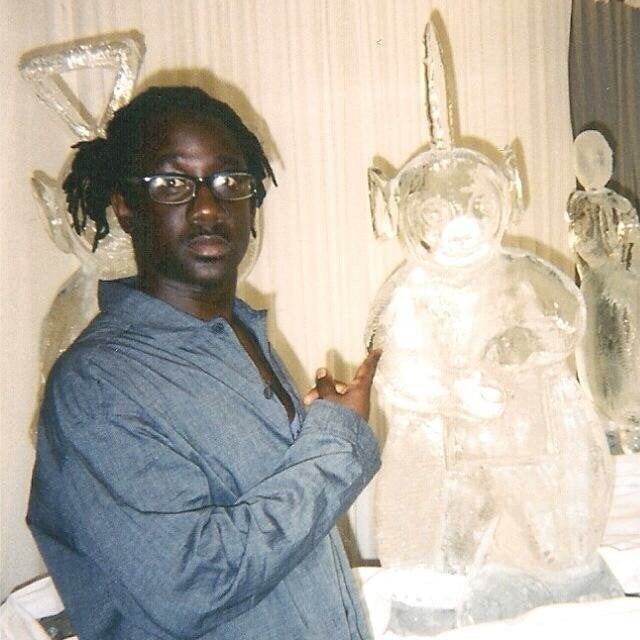Dipsy, the green Teletubby with a penchant for his hat, always stood out as the non-conformist of the group. This independent spirit mirrored John Simmit, the actor who brought Dipsy to life. Simmit, a proud Cuban-Jamaican-Brummie, infused the role with his rich heritage, adding layers of cultural depth that resonated far beyond Teletubbyland.
“Being a Cuban-Jamaican-Brummie with a background in comedy and music, I really leaned into that for Dipsy,” John Simmit explained in a recent interview. “There were a lot of cultural nods woven in.” For those in the know, Dipsy’s playful gibberish, like “Papa Come Papa Come To Po,” was more than just baby talk. It was Simmit’s homage to classic reggae rhythms, specifically referencing “The Whip.” Beyond the sounds, Simmit subtly incorporated Jamaican dance moves, slipping in a ‘Bogle’ or a ‘Tatty’ – small winks to his culture that eagle-eyed viewers picked up on and appreciated. This cultural infusion was a key element in Dipsy’s unique charm and the show’s global appeal.
Launched in 1997, Teletubbies quickly became a worldwide phenomenon. Broadcasting in over 120 countries and translated into 45 languages, the initial 365 episodes, concluding in 2001, generated an astounding £1 billion in merchandise sales. The Teletubbies weren’t just a children’s show; they were a cultural moment. They received the keys to New York City and even topped the music charts with “Teletubbies say Eh-oh!”, narrowly missing the Christmas number one spot in 1997, beaten only by the Spice Girls. The fab four reached a level of fame akin to Beatlemania, swapping the Yellow Submarine for the idyllic, green hills of their fantastical world.
 John Simmit in costume as Dipsy on the set of Teletubbies.
John Simmit in costume as Dipsy on the set of Teletubbies.
Behind the on-screen magic, however, lay the less glamorous realities of performance. “Running around in a three-stone, eight-foot tall bright green costume in the summer is no joke,” Simmit confessed, recalling the original Teletubbies set in Stratford-upon-Avon. Despite the physical discomfort, the role was demanding. “You had to roll down hills, squat, jump, hug – you had to make it look effortlessly fun when it was actually a serious workout.”
John Simmit’s dedication paid off. Even today, reruns of Teletubbies continue to air on the BBC and garner millions of views on YouTube, reaching up to 100 million monthly. The show even enjoyed a 21st-century revival in 2015, proving its enduring appeal to new generations of tech-savvy toddlers. But beyond the continued popularity, many are still curious about the behind-the-scenes secrets of this iconic children’s program. Simmit sheds light on some of the most frequently asked questions, revealing the reality of life inside a Teletubby suit and the show’s lasting impact on his life.
The Teletubby suits themselves were a feat of engineering, albeit not always comfortable. Simmit explained that the original costumes contained mechanisms to animate the eyes and mouth. Later versions even included small seats, offering brief respite between takes. Despite these additions, the actors faced constant heat and exertion. “We had to wear these incredibly unattractive long johns underneath, essentially a onesie, to absorb the sweat,” Simmit revealed. The heat and sweat were so intense that after filming, the actors were, in his words, “reeking and so sweaty you could wring us out,” a testament to the challenging physical demands of the role.
 John Simmit and the Teletubbies cast, Simon Shelton (Tinky Winky), Pui Fan Lee (Po), and Nicola Jane Smedley (Laa-Laa) in costume.
John Simmit and the Teletubbies cast, Simon Shelton (Tinky Winky), Pui Fan Lee (Po), and Nicola Jane Smedley (Laa-Laa) in costume.
Teletubbyland, the vibrant setting for the show, was brought to life by a dedicated crew of over 50 people. Designers, camera operators, lighting technicians, writers, producers, and the show’s creators, Andrew Davenport and Anne Wood, all contributed to the immersive world. To create the illusion of the Teletubbies’ small stature, the production team employed forced perspective, most notably using Flemish Giant rabbits, the world’s largest rabbit breed. “I think that was Anne’s way of playing with perspective and making us look small,” Simmit speculated. These giant rabbits, intended to make the Teletubbies appear diminutive, sometimes added unexpected challenges to filming, with their active mating habits occasionally interrupting takes.
@Azniac FUN FACT! Since the Teletubbies were huge, they had to use huge rabbits to make them look proportionate pic.twitter.com/YEDySRQwu0
— big dumb idiot (@JuanTon88) May 14, 2013
The meticulous detail extended to every aspect of Teletubbyland. From the iconic dome-shaped Tubbytronic Superdome to props like the Noo-noo, everything was custom-built and oversized. Even the Tubby Custard, a staple in the Teletubbies’ diet, was specially created. “I hate to break the illusion, but it definitely wasn’t for eating,” Simmit admitted. Initially made from mashed potatoes and acrylic paint, it was later replaced with an edible version. The custard was delivered to the Teletubbies via tubes hidden in their costumes, adding another layer of surrealism to the production.
Despite the sometimes challenging conditions, the Teletubbies cast developed a unique camaraderie. They even invented their own form of playful banter, cursing each other in Tubby speak. “It was surreal, definitely a very surreal show,” Simmit reflected. Yet, amidst the surrealism, everyday life continued. “Between takes, we’d have normal conversations about the news and the general election, sometimes slipping into the Teletubby voices,” he chuckled, highlighting the bizarre contrast between their roles and reality. This inherent strangeness inadvertently contributed to the show’s cult following, particularly among university students, drawing parallels to the psychedelic appeal of shows like The Magic Roundabout.
 An aerial shot of the Teletubbyland set in Warwickshire, England, during its filming period from 1997 to 2001.
An aerial shot of the Teletubbyland set in Warwickshire, England, during its filming period from 1997 to 2001.
Recognizing the physical demands of the roles, producers prioritized the cast’s well-being. “I remember we’d get a massage once a week,” Simmit recalled. Initially appreciating the gesture as a sign of care, he later understood the pragmatic reason behind it. “At the time, I thought it was such a lovely, caring company, but then you realize they weren’t just being nice. They were protecting their investment. There were no understudies. There were only four of us, and if one of us got injured, filming would have to stop.”
While their Teletubby days are behind them, the original cast members have remained connected, though they mourned the loss of Simon Shelton, who played Tinky Winky, in 2018. Nicola Jane Smedley, Laa-Laa, is currently writing a book about her experiences as a Teletubby, and Pui Fan Lee, Po, continues her career as a presenter on CBeebies.
John Simmit has also continued to thrive creatively. He is currently developing “Rush,” a musical celebrating the Windrush generation, a deeply personal project inspired by his parents’ experiences. This musical is a testament to Simmit’s commitment to his heritage and his artistic versatility. He also founded Upfront Comedy, playing a significant role in building the Black comedy scene in the UK.
Even though decades have passed since his Teletubby days, Dipsy remains a significant part of John Simmit’s identity. His Instagram account is sprinkled with images of his green alter ego, a nod to the character that brought him global recognition. His daughters, who grew up watching Teletubbies, have come to terms with their dad’s iconic role. “Growing up, they both watched Teletubbies, and it was surreal seeing yourself on TV through their eyes, but also a beautiful moment to share what you do with your family,” he shared. Ultimately, his role as Dipsy even earned him the coveted title of “cool dad” in his daughters’ eyes.
 John Simmit posing with a Dipsy ice sculpture.
John Simmit posing with a Dipsy ice sculpture.
“Teletubbies has become a cultural phenomenon, and it continues to be because there’s simply nothing else like it,” Simmit concluded. “The demand has never really faded because it had such a profound impact on people’s lives.” He believes the show’s enduring appeal lies in its simple message of love and joy. “At the end of the day, our job was to mess around, dance, hug, and blink at the camera, trying to make children laugh and smile, and I think we achieved that. Teletubbies evokes the same warm, nostalgic feelings as happy memories with friends. There’s definitely no frowning in Teletubbyland.”


